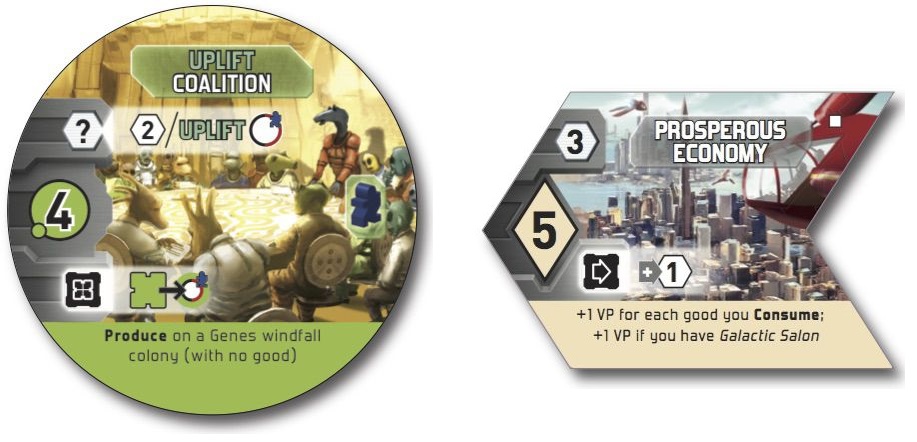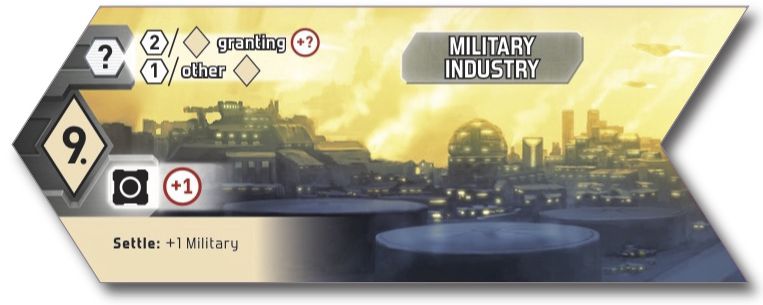New Frontiers (Boardgame)
 New Frontiers has players taking turns to select an action card, which then dictates the action that is performed by all players. Through the course of the game, players settle planets, build developments, and exchange goods for points or profit. Develop the best economy (be it building, exchanging, settling, or a combination of them) to be crowned the winner of the game. This 2-5 player game is a great, family-friendlier version of the popular Race for the Galaxy card game.
New Frontiers has players taking turns to select an action card, which then dictates the action that is performed by all players. Through the course of the game, players settle planets, build developments, and exchange goods for points or profit. Develop the best economy (be it building, exchanging, settling, or a combination of them) to be crowned the winner of the game. This 2-5 player game is a great, family-friendlier version of the popular Race for the Galaxy card game.
New Frontiers
Designer: Thomas Lehmann
Publisher: Rio Grande Games
Players: 2-5
Ages: 14+
Time: 45-75 min
(review copy provided by publisher)
For many years, the top rated boardgame in the world was Puerto Rico, where players develop an economy through role selection (one person chooses, all players participate) and attempt to score points through building buildings and shipping goods. Five years later, much of the spirit of the game was copied with the now very popular card game, Race for the Galaxy. It has the same role selection, building things, and shipping goods. However, as a card game, there are far, far more buildings and other effects involved allowing for players to discover and exploit “combinations” of cards that produce synergistic effects. A second take on the game was in the excellent Roll for the Galaxy, which is a similar game but emphasizes the use of dice for selecting roles and developing ones’ economy. New Frontiers comes full circle to its roots, becoming a boardgame once again but retaining the space theme as well as its tendency towards allowing interesting combinations of special powers.

Players begin the game with a starting planet, along with its special ability. The arc of the game has players settling new planets, buying developments, collecting goods, and then either selling those goods for cash, or “consuming” them for victory points. Planets form the primary source of goods, and often have a small additional ability like a way to consume said goods. Developments are purchased from a central stock and provide a special power, often breaking one of the other standard rules for the game.
Each round has players taking turns to select an action (considered the “role” chosen) and then it is performed by all players, with a small bonus to the active player. The game tends to go into common cycles of producing goods on planets, exchanging goods for money or points, and then spending that money on additional developments and/or planets. There are 8 different roles in each game, and each one can only be selected once per round. The roles are:
- Develop – Players spend cash to purchase an upgrade from the main tableau and place it onto their playmat. These range in price from low to high and typically improve a player’s options when a specific role is chosen. Special, 9-cost developments take up two spaces on a player’s playmat. While they don’t provide points by themselves, they provide a strong power and give bonus points for satisfying related conditions (like collecting specific types of planets or developments.) The active player (the person who picked the role) may buy their development at -1 cost.
- Explore – The active player draws planets from a bag and picks one. The rest of the players draft a planet and the active player gets to pick a second planet from the leftovers. These planets are set aside in one’s playmat until they are Settled to activate them.
- Settle – Players may either choose to gain two colonists or settle one planet. To settle a planet, a player takes one (or two for some planets) settlers from their playmat and places them on the selected world. Players must also either pay the cost of the planet, or have equal or greater than the planet’s military power (in the case of military worlds,) in which case there is no monetary cost. The active player gains one settler figure before choosing their settle action (gain 2 more colonists or settle one planet.)
- Produce – All solid color planets produce a good, as long as they don’t already have a good on the planet (there is a hard limit of 1 good per planet.) Not all planets have a color, colorless planets produce no goods. Some planets are “windfall” planets and have a colored “halo” (not solid) around them. These also do not produce goods, but do come with one free good when they are initially settled. The active player is allowed to produce a good on one of their windfall worlds when they select this action. In addition, if no one chooses this action in a round, money is added to the card and is given as a bonus to the next person to choose this action.
- Trade & Consume – All players may first sell one good for money. Each of the four colors are worth a different cost, with yellow “Alien” worlds worth the most. After selling players must use as many “Consume” powers as possible. They typically award victory points but may also provide money or other effects. The active player gains 1 victory point for choosing this action.
- Send Diplomatic Envoys – This grants the active player 1 victory point and puts them at the front of the turn order for future rounds. (This is sometimes taken by the last player, after which the next round begins and they get to take the first action of the new round.)
- Retreat into Isolation – Retreat into Isolation simply gives the active player 2 credits (money.)
- Chart Galactic Goals – In the advanced version of the game this replaces the Retreat into Isolation card. Players selecting this gain 1 credit and get to move their turn position up one space. In addition, the player draws three goal cards for the game, selects one and returns the rest to the bottom of the goal pile. They may keep the new goal face up or face down, but all other goals are turned face-up. (There is only one face-down goal card at any time.) Goal cards give players additional ways to score points at the end of the game. They can give bonuses for collecting things (like goods or colonists) or owning a variety of things (different types of planets, etc…)

Players take turns selecting roles and all taking actions until the game end is triggered. This happens if someone builds 10 or more spaces of developments, founded 7 or more colonies, run out of settlers (5 or less), or running out of victory point chips given out for the consumption action. If any of these conditions are met, the game will end at the end of that round. Players add up their scores, including bonuses (from 9 pt developments and/or goal cards – whether face-up or face-down) and a victor is declared. Ties go to the player with the most credits and goods.
Verdict:
“Back in the day” I thoroughly enjoyed playing Puerto Rico. There were many decent paths to victory, however player order was a factor. Less experienced players could easily make decisions that greatly benefited the player to their left. Therefore, it was a somewhat “harsh” game as players always needed to keep their opponents’ strategy in mind and attempt to get in the way. When Race for the Galaxy came along, I was quickly enamored with it. It had some similarities with role selection but the large deck of cards provided a huge variety of options, which gave players a chance to seek out interesting combinations as they played. The standard game was a huge hit and several expansions were produced. While they were great for adding variety and keeping the game from going stale, it also added greater complexity as the possible card combinations continued to increase. This made the game much less accessible to new players. Experienced players would know most of the cards available in the deck while new players would be floundering around without knowing the possible uses of their current hand of cards.

Perhaps the best thing going for New Frontiers is its accessibility. While the set of planets in the game are unknown, all the developments are laid out at the beginning of play. This means there is a lot to grasp at the beginning of the game, but it limits the problem of getting to the mid-game and still trying to figure out what sorts of interesting combinations are available. The shared pile of developments and drafting of explored planets move the game away from the almost simultaneous selection processes in earlier games, but I’m willing to give up that cost. As far as I have ascertained in my games, there are still a variety of viable strategies to pursue. Some players find the starting planets to dictate which strategies a player should choose. I have not been bothered by this, and am still enjoying working through the various starting planets. Over half of the developments on the tableau are double-sided, which makes each game more unique. Of course, the wealth of variety in previous incarnations of the game is partly due to the many expansions that have come along. New Frontiers does suffer a bit from this, but its first expansion will appear in early 2020 and should help with that situation.
Overall, I like the game. I think it is the easiest game in the series to learn, and is typically easy enough to grasp in one’s first game. This more “friendly” style means it will see more play in my collection. As a member of the “my game collection is too huge” club, the size of the box and components seem to be on the large side. However, the large playing pieces, gaudy plastic “goods cubes”, and the rest of the board does serve to make the game more “attractive” to anyone who is looking for something in addition to the core rules and gameplay.
Kid Factor
This is a fairly complex game, requiring forethought and strategy. There is not a lot of reading, but each planet and development have their own special rules. The art is futuristic but not cartoon-ish, but is not dark or an angst-ridden sort of apocalyptic future. I’d say it’s a game best for early teens or older.





Discussion Area - Leave a Comment